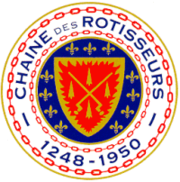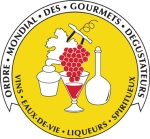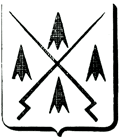
Confrérie de la Chaîne des Rôtisseurs
Encyclopedia

Gastronomy
Gastronomy is the art or science of food eating. Also, it can be defined as the study of food and culture, with a particular focus on gourmet cuisine...
society founded in Paris
Paris
Paris is the capital and largest city in France, situated on the river Seine, in northern France, at the heart of the Île-de-France region...
in 1950. The Chaîne is based on the traditions and practices of the old French
France
The French Republic , The French Republic , The French Republic , (commonly known as France , is a unitary semi-presidential republic in Western Europe with several overseas territories and islands located on other continents and in the Indian, Pacific, and Atlantic oceans. Metropolitan France...
royal guild
Guild
A guild is an association of craftsmen in a particular trade. The earliest types of guild were formed as confraternities of workers. They were organized in a manner something between a trade union, a cartel, and a secret society...
of goose
Goose
The word goose is the English name for a group of waterfowl, belonging to the family Anatidae. This family also includes swans, most of which are larger than true geese, and ducks, which are smaller....
roasters
Roasting
Roasting is a cooking method that uses dry heat, whether an open flame, oven, or other heat source. Roasting usually causes caramelization or Maillard browning of the surface of the food, which is considered by some as a flavor enhancement. Roasting uses more indirect, diffused heat , and is...
, whose authority gradually expanded to the roasting of all poultry
Poultry
Poultry are domesticated birds kept by humans for the purpose of producing eggs, meat, and/or feathers. These most typically are members of the superorder Galloanserae , especially the order Galliformes and the family Anatidae , commonly known as "waterfowl"...
, meat
Meat
Meat is animal flesh that is used as food. Most often, this means the skeletal muscle and associated fat and other tissues, but it may also describe other edible tissues such as organs and offal...
and game
Game (food)
Game is any animal hunted for food or not normally domesticated. Game animals are also hunted for sport.The type and range of animals hunted for food varies in different parts of the world. This will be influenced by climate, animal diversity, local taste and locally accepted view about what can or...
. It is dedicated to fine cuisine
Cuisine
Cuisine is a characteristic style of cooking practices and traditions, often associated with a specific culture. Cuisines are often named after the geographic areas or regions that they originate from...
and promoting and developing the gastronomic values while at the same time widening its focus to table art.
History
The written history of the guild of "Les Oyers" or "Goose Roasters" has been traced back to the year 1248. At that time King Louis IXLouis IX of France
Louis IX , commonly Saint Louis, was King of France from 1226 until his death. He was also styled Louis II, Count of Artois from 1226 to 1237. Born at Poissy, near Paris, he was an eighth-generation descendant of Hugh Capet, and thus a member of the House of Capet, and the son of Louis VIII and...
, assigned Étienne Boileau
Étienne Boileau
Étienne Boileau was one of the first known provosts of Paris. In 1261, he was named provost , by King Louis IX. He authored the , a collection of the statutes of the Parisian trade guilds, including the standards for gold and silver alloys...
, the Provost
Provost (civil)
A provost is the ceremonial head of many Scottish local authorities, and under the name prévôt was a governmental position of varying importance in Ancien Regime France.-History:...
of Paris, with the task of bringing order into the organization of trades and guilds, developing young apprentices and improving the technical knowledge of guild members. He gathered together the charters of more than 100 of these trades, among them the Goose Roasters.
Over the years, the activities and privileges of the Goose Roasters Guild were extended to preparing and selling all kinds of meat, including poultry
Poultry
Poultry are domesticated birds kept by humans for the purpose of producing eggs, meat, and/or feathers. These most typically are members of the superorder Galloanserae , especially the order Galliformes and the family Anatidae , commonly known as "waterfowl"...
and venison
Venison
Venison is the meat of a game animal, especially a deer but also other animals such as antelope, wild boar, etc.-Etymology:The word derives from the Latin vēnor...
.
In 1509, during the reign of King Louis XII
Louis XII of France
Louis proved to be a popular king. At the end of his reign the crown deficit was no greater than it had been when he succeeded Charles VIII in 1498, despite several expensive military campaigns in Italy. His fiscal reforms of 1504 and 1508 tightened and improved procedures for the collection of taxes...
, some new statutes were introduced, which resulted in the change of the name of the guild to "Rôtisseurs" and its activities were restricted to poultry
Poultry
Poultry are domesticated birds kept by humans for the purpose of producing eggs, meat, and/or feathers. These most typically are members of the superorder Galloanserae , especially the order Galliformes and the family Anatidae , commonly known as "waterfowl"...
, game birds, lamb and venison
Venison
Venison is the meat of a game animal, especially a deer but also other animals such as antelope, wild boar, etc.-Etymology:The word derives from the Latin vēnor...
. In 1610, under King Louis XIII, the guild was granted a royal charter and its own coat of arms
Coat of arms
A coat of arms is a unique heraldic design on a shield or escutcheon or on a surcoat or tabard used to cover and protect armour and to identify the wearer. Thus the term is often stated as "coat-armour", because it was anciently displayed on the front of a coat of cloth...
.
For over four centuries, the "Confrérie" or brotherhood of the Roasters cultivated and developed culinary art and high standards of professionalism and quality—standards befitting the splendor of the "Royal Table"—until the guild system was disbanded, together with all others, in 1793 during the French Revolution
French Revolution
The French Revolution , sometimes distinguished as the 'Great French Revolution' , was a period of radical social and political upheaval in France and Europe. The absolute monarchy that had ruled France for centuries collapsed in three years...
. The Rôtisseurs were almost forgotten until 1950 when Dr. Auguste Becart, Jean Valby and "Prince" Curnonsky
Curnonsky
Maurice Edmond Sailland , better known by his pen-name Curnonsky , and dubbed the Prince of Gastronomy, was the most celebrated writer on gastronomy in France in the 20th century. He wrote or ghost-wrote over 65 books and enormous numbers of newspaper columns...
, and chefs Louis Giraudon and Marcel Dorin resurrected the Society and created La Confrérie de la Chaîne des Rôtisseurs.
The Chaîne Today

Wine
Wine is an alcoholic beverage, made of fermented fruit juice, usually from grapes. The natural chemical balance of grapes lets them ferment without the addition of sugars, acids, enzymes, or other nutrients. Grape wine is produced by fermenting crushed grapes using various types of yeast. Yeast...
and fine dining. While a confrérie is a "brotherhood," women have always been welcome and they take an active role in the Society. Within the Chaîne there is also the "L'Ordre Mondial des Gourmets Dégustateurs" for those members who have a special knowledge of, or interest in, wine and spirits
Distilled beverage
A distilled beverage, liquor, or spirit is an alcoholic beverage containing ethanol that is produced by distilling ethanol produced by means of fermenting grain, fruit, or vegetables...
.
The international headquarters (Siège Mondial) remains in Paris
Paris
Paris is the capital and largest city in France, situated on the river Seine, in northern France, at the heart of the Île-de-France region...
where the society was founded, and the present day Chaîne des Rôtisseurs is still based on the traditions and practices of the ancient French brotherhood but now in an international and contemporary context.
The organization is represented by its 24000 members in 75 countries around the world. In these countries, it is organized in national sections (called Bailliages) with regional subsections.
A small group of representatives from the Confrérie were guest judges on Season 3 Episode 4 of TV Show Top Chef.
Jeunes Chefs Rôtisseurs Competition
La Chaîne des Rôtisseurs organizes a cooking competition for young chefChef
A chef is a person who cooks professionally for other people. Although over time the term has come to describe any person who cooks for a living, traditionally it refers to a highly skilled professional who is proficient in all aspects of food preparation.-Etymology:The word "chef" is borrowed ...
s under the age of 27, sponsored by a professional Chaîne member. The purpose of this competition is to encourage and promote the culinary expertise of young chefs in the tradition of the Chaîne des Rôtisseurs by exposing them to a competitive environment with their peers. This competition offers the opportunity for the Jeunes Commis to showcase their talents and creativity in an international arena. The goal of the competition is to encourage cultural differences in food presentation and preparation using a traditional approach.
The competition is a "black box" competition, where the competitor does not know the ingredients he is to cook with until his arrival at the competition. He then has 30 minutes to write a menu, and three and a half hours to prepare a three-course dinner for four people.
Competition
The Jeunes Chefs Competition was first organized in 1977 in Switzerland to support and promote future young chefs by giving them the opportunity to demonstrate their skills. Competitions are held at regional, national and international levels in countries around the world.Competition begins at the regional level. Proprietors, managers, chefs and culinary instructors at Chaîne affiliated restaurants, hotels and culinary schools. Contestants are then selected from the group of applicants.
At the appointed time, each contestant is given an identical, previously unidentified "market basket" containing certain basic ingredients. Using all of these ingredients, as well as drawing on a variety of staples from a pantry, the contestant must compose and execute a 3-course menu (first course, main course, and dessert) for four people. The written menu must be completed within the first half-hour, with 3½ hours allowed for preparation, after which the finished dishes are presented to be judged within a 45-minute window.
Judging
Experienced professionals who are Chaîne members, are selected to serve as judges. A candidate's sponsor may not serve as a judge. To ensure complete secrecy and objectivity, contestants are identified by number only rather than by name.Dishes prepared by the contestants are judged on taste, presentation and originality. In addition, scores are given for cleanliness and organization in the kitchen.
Eligibility
The competition is open to young cooks under the age of 27 at the time of the international competition, who are sponsored by a professional Chaine member. Once accepted, a candidate must furnish proof of age.A candidate must be nominated by their employer, who must be a member of the Chaine des Rotisseurs, and accepted by the Competition Committee. The act of participating in the Competition at any level imposes upon the competitor the acceptance and respect of the rules.
Winners of past Chaine Regional Young Chefs Competitions are not eligible to compete. Past contestants (non-winners) may compete regionally for a second time, as long as they are eligible under the age and experience ruling.
Competition levels
The first place winners of all Regional Competitions are qualified to participate in their country's National Final. The winner of the national final will compete in the International Competition.Coat of arms

Rotisserie
Rotisserie is a style of roasting where meat is skewered on a spit - a long solid rod used to hold food while it is being cooked over a fire in a fireplace or over a campfire, or roasted in an oven. This method is generally used for cooking large joints of meat or entire animals, such as pigs,...
s and four larding needles, surrounded by flames of the hearth
Hearth
In common historic and modern usage, a hearth is a brick- or stone-lined fireplace or oven often used for cooking and/or heating. For centuries, the hearth was considered an integral part of a home, often its central or most important feature...
on a shield
Shield
A shield is a type of personal armor, meant to intercept attacks, either by stopping projectiles such as arrows or redirecting a hit from a sword, mace or battle axe to the side of the shield-bearer....
.
For the new Confrérie, a logo
Logo
A logo is a graphic mark or emblem commonly used by commercial enterprises, organizations and even individuals to aid and promote instant public recognition...
was created which used the former historic shield in the center. It was encircled with fleur-de-lis
Fleur-de-lis
The fleur-de-lis or fleur-de-lys is a stylized lily or iris that is used as a decorative design or symbol. It may be "at one and the same time, political, dynastic, artistic, emblematic, and symbolic", especially in heraldry...
and two chain
Chain
A chain is a sequence of connected links.Chain may also refer to:Chain may refer to:* Necklace - a jewelry which is worn around the neck* Mail , a type of armor made of interlocking chain links...
s, between which the new name of the Society and the foundation dates of 1248 and 1950 were written.
The inner chain represents the professional members; the outer chain the non-professional members and the bond, which unites all of the members.
External links
- Official website of the international headquarters of the Chaîne des Rôtisseurs
- Chaîne des Rôtisseurs Canada
- Chaîne des Rôtisseurs USA
- Chaîne des Rôtisseurs Great Britain
- Chaîne des Rôtisseurs Australia
- Descriptions and images of the various types of chains and ribbons awarded by Chaîne members
- "Knights of the Dining Table" Article about the Chaîne des Rôtisseurs Hawaii. Maui No Ka 'Oi MagazineMaui No Ka 'Oi MagazineMaui Nō Ka Oi Magazine is a bi-monthly regional magazine published by the Haynes Publishing Group in Wailuku, Hawaii.The phrase Maui nō ka ʻoi means "Maui is unparallel" in the Hawaiian language. Maui Nō Ka Oi Magazine features stories relating to the culture, art, dining, environmental issues,...
Vol 11. No.1 (Jan.2007).

